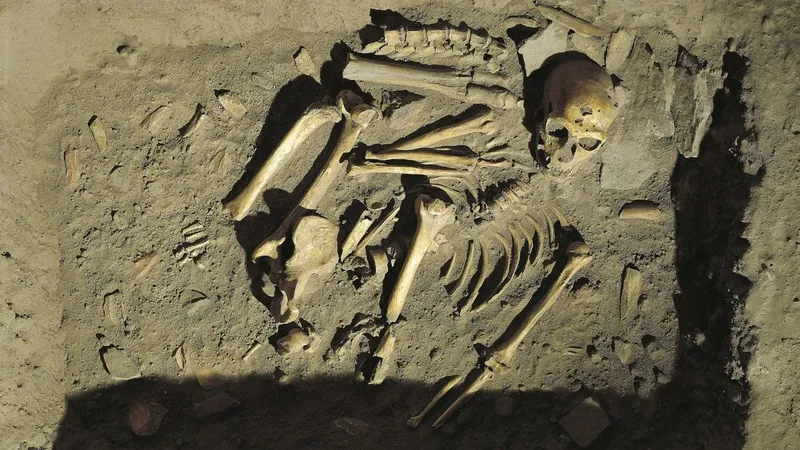
Revealing the Death Rituals of Our Ancestors: Neanderthal vs. Early Homo Sapiens Burials
2024-11-22
Author: Wei Ling
Introduction
A recent groundbreaking study sheds light on the striking differences in burial practices between Neanderthals and early Homo sapiens, offering fresh insights into our ancient relatives. While both groups are recognized as some of our closest extinct kin, how they treated their deceased reveals significant cultural disparities.
Burial Practices of Neanderthals and Early Homo Sapiens
Neanderthals and early Homo sapiens are currently the only known hominins known to engage in burial practices, which involve placing the dead in designated locations and covering them. As study lead author Ella Been, a paleoanthropologist from Tel Aviv University, explains, "We know there are other hominins with some form of mortuary practices, but none matched the systematic burials performed by Neanderthals and early humans."
Research Methodology
To explore the nuances of these burial traditions, Been and her colleague Omry Barzilai from the University of Haifa conducted an analysis of 32 burial sites — 17 belonging to Neanderthals and 15 to early Homo sapiens. These sites, dating back 35,000 to 120,000 years, were located in Western Asia, a region where both groups coexisted.
Similarities in Burial Customs
The researchers identified noteworthy similarities in their burial customs. Both groups buried people of all ages — from infants to the elderly — and often accompanied the remains with various grave goods. For example, Neanderthal gravesites have revealed items like wild goat horns and tortoiseshells, while early Homo sapiens were often interred with deer antlers and ochre, a mineral linked to ritualistic practices.
Contrasts in Burial Practices
However, stark contrasts also emerged. Neanderthals typically interred their dead within caves, whereas early Homo sapiens preferred outdoor or cave entrance burials. Additionally, early Homo sapiens predominantly positioned their deceased in a fetal pose, heads flexed toward their chests, while Neanderthals exhibited a wider range of burial positions.
Cultural Patterns
Paleoanthropologist John Hawks from the University of Wisconsin–Madison, who did not participate in the study, noted that these findings suggest consistent burial practices emerged in these hominin groups despite their geographic dispersal. "It's intriguing to witness shared cultural patterns among relatively small and scattered populations," he stated.
Origins of Burial Practices
Perhaps most astonishing is the evidence indicating that the practice of burial among both Neanderthals and early Homo sapiens may have originated simultaneously — around 90,000 to 120,000 years ago — in the Levant region. This area, encompassing modern-day countries like Israel and Lebanon, has long been theorized as a key migration point for hominins leaving Africa.
Significance of the Levant Region
Been expressed surprise at this revelation, stating, "Only after we compared their burial habits did we realize that all subsequent burial sites in Africa and Europe appeared after those in the Levant." This underscores the significance of the region as a cultural crossroads.
Cultural Exchange
Moreover, previous theories suggest that Neanderthals and early Homo sapiens might have shared knowledge and practices in this area. Fascinatingly, if you examine artifacts from coexisting Neanderthal and early Homo sapiens sites from 250,000 to 50,000 years ago, it's challenging to distinguish which hominin left them behind, reinforcing the notion of potential cultural exchange.
Necessity of Burial Practices
However, this sharing of practices may have also been a matter of necessity. "When multiple groups inhabit the same territory and compete for resources, establishing burial practices can signify territorial claims," Been commented, hinting at a deeper ritualistic significance for these early customs.
Need for Further Research
Despite these insights, Hawks cautions against hastily concluding that early burial practices emanated from a single source in the Levant. The modest number of burials analyzed in this study may not definitively support such a theory. "There's still a lot we don’t know, and the data doesn't robustly demonstrate a flow of ideas from one origin," he remarked.
Conclusion
Both Been and Hawks agree on the need for further research. "We should conduct more excavations," Been affirmed. "In a few years — or perhaps much longer — we might uncover additional burial sites that could reshape our understanding of early human practices." As researchers continue to dig deeper into our ancestors' lives and deaths, it becomes increasingly apparent that the story of humanity is complex, woven with threads of ritual, culture, and perhaps even shared understandings between these two significant groups of our evolutionary history.



 Brasil (PT)
Brasil (PT)
 Canada (EN)
Canada (EN)
 Chile (ES)
Chile (ES)
 España (ES)
España (ES)
 France (FR)
France (FR)
 Hong Kong (EN)
Hong Kong (EN)
 Italia (IT)
Italia (IT)
 日本 (JA)
日本 (JA)
 Magyarország (HU)
Magyarország (HU)
 Norge (NO)
Norge (NO)
 Polska (PL)
Polska (PL)
 Schweiz (DE)
Schweiz (DE)
 Singapore (EN)
Singapore (EN)
 Sverige (SV)
Sverige (SV)
 Suomi (FI)
Suomi (FI)
 Türkiye (TR)
Türkiye (TR)